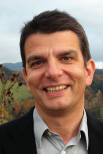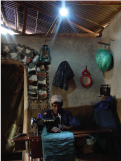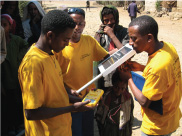
Harvesting the Power of the Sun
in Rema
The Solar Energy Foundation and Good
Energies Bring Electicity to Ethiopian Village
Sep 12, 2008 - Clinton Global Initiative
On July 31, President Clinton visited
the rural community of Rema, the first “solar village”
in Ethiopia. After making a Commitment to Action at
the Clinton Global Initiative Annual Meeting in 2006,
the Solar Energy Foundation (SEF) and Good Energies,
Inc. installed 1,100 solar panels in Rema, generating
electricity for more than 5,500 people. Access to
electricity has made night school and refrigerated
medicine possible and has improved villagers’ eyesight.
“Renewable energy is the economic opportunity of this
century,” said Marcel Brenninkmeijer, chairman of
Good Energies. We recently had the opportunity to
ask Harald Schutzeichel, director and CEO of the Solar
Energy Foundation, about his commitment in Rema. In
1998 Dr. Schutzeichel established the first solar
company in Germany to have solar shares in Europe,
and in 2005 he founded the Solar Energy Foundation.
 Q.
What brought you to Rema? Q.
What brought you to Rema?
A. Normally, an NGO installs a diesel
generator, while the people are responsible for finding
fuel, ensuring maintenance, etc. However, the villagers
of Rema said they don’t want a technology they cannot
pay for, especially since diesel is becoming more
and more expensive. That is why the inhabitants of
Rema asked us for solar energy. They knew about the
technology from a previous, smaller project we had
installed about one year ago. Our project in Rema
is very important to us because it demonstrates the
ways in which solar energy can be used and make a
difference. We have installed solar home systems for
light, radio, and cassette recorders in more than
1,000 huts. It is the largest solar project in East
Africa to date.
 Q.
President Clinton was impressed by the impact you
have had in Rema in a short time. What SEF sites in
Rema did President Clinton visit? Q.
President Clinton was impressed by the impact you
have had in Rema in a short time. What SEF sites in
Rema did President Clinton visit?
A. President Clinton visited the evening
school for adults, a project initiated by the women
of Rema after our team installed the light. Many of
these women have stated that the light gave them the
chance to learn how to read and write, something which
was previously impossible.
Q. There are many components to your
work in Rema, including solar energy production and
solar water pumps. What has been the community’s response
to these approaches?
A. People are extremely happy to have
a safe and reliable source of lighting. Light is needed
after sunset, which is around 6 p.m. in Ethiopia.
Children require sufficient lighting to do their homework,
and adults need better lighting to improve their living
and working conditions. Paraffin lamps have been the
only source of lighting in the countryside. Apart
from producing about 160 kilograms (352 pounds) of
carbon dioxide, these lights are very weak and can
cause eye damage. Solar energy, on the other hand,
provides people with lighting that is affordable,
healthy, and safe. Furthermore, light at night is
a symbol that development in rural areas is possible.
 Q.
What impact could this commitment have within Ethiopia
and throughout rural regions in Africa? Q.
What impact could this commitment have within Ethiopia
and throughout rural regions in Africa?
A. Our aim is to initiate a self-supported
solar business. Communities across Africa do not need
our alms; instead, they could benefit from our expertise
in solar energy, which could help them become self-sufficient.
Q. How did you develop your partnership
with Good Energies and how has it accelerated your
work?
A. Good Energies is one of our most
loyal and special partners. They have been with us
since our first project in 2005, and have committed
to support our work over the next few years. This
is extremely important, as the success of our projects
depends on sustainable and reliable partnerships.
Without their trust and commitment, our work in Rema
would not have been impossible.
Photos courtesy of the Solar Energy
Foundation (Stiftung Solarenergie)

|